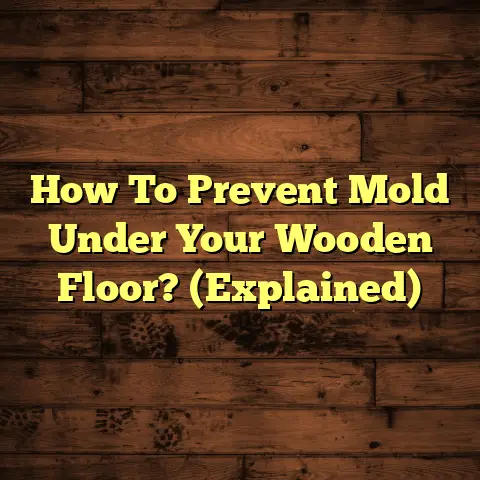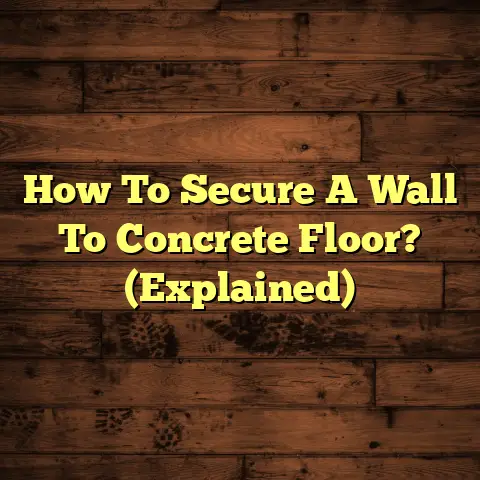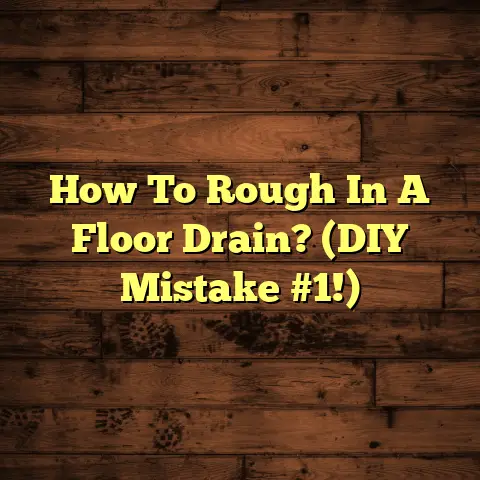Polished Concrete Floors: Benefits? (4 Contractors Hide!)
I get it. As a flooring contractor for over 15 years, I’ve seen it all. And let me tell you, choosing the right flooring is a big deal. It impacts your home’s style, your budget, and even your health.
Lately, I’ve been installing more and more polished concrete floors. Why? Because they’re a fantastic, modern option that’s gaining serious traction in both homes and businesses.
Think sleek, stylish, and surprisingly cost-effective.
Now, I know what you might be thinking: “Concrete? That sounds cold and industrial!”
But trust me, polished concrete has come a long way.
It’s not just for warehouses anymore.
One of the biggest reasons people are drawn to polished concrete is the potential for serious cost savings. But that’s not all!
In this article, I’m going to break down the benefits of polished concrete floors, and I’m even going to let you in on four “hidden” advantages that some contractors (myself included, sometimes!) don’t always highlight. Let’s dive in!
The Cost-Effectiveness of Polished Concrete Floors
Okay, let’s talk money. Flooring can be a major expense, so understanding the cost implications is crucial.
When you’re comparing polished concrete to other popular options like hardwood, tile, or carpet, the initial investment can seem similar, or even slightly higher in some cases.
For example, according to HomeAdvisor, the average cost to install hardwood flooring ranges from $6 to $12 per square foot, while tile can range from $8 to $15 per square foot. Carpet is often cheaper upfront, at around $3 to $8 per square foot.
Polished concrete typically falls in the range of $3 to $12 per square foot, depending on the complexity of the project and the desired finish.
But here’s where the real magic happens: long-term savings.
Durability is Key:
Hardwood can scratch and dent easily, tile can crack, and carpet? Well, let’s just say spills and stains are inevitable. All of these issues lead to repairs or replacements down the road.
Polished concrete, on the other hand, is incredibly durable. It can withstand heavy foot traffic, resist stains, and even hold up well against moisture (with proper sealing, of course).
Think about it this way: I worked on a retail space about 10 years ago that opted for polished concrete. They still call me to say how great the floor is. They have had no issues with needing repairs or replacements.
That’s a huge difference compared to, say, replacing carpet every 5-7 years in a high-traffic area.
Maintenance Matters:
Another factor to consider is maintenance. Hardwood requires regular polishing and special cleaners.
Tile needs grout cleaning (ugh!). Carpet needs constant vacuuming and occasional deep cleaning.
Polished concrete? A simple sweep and occasional mopping are usually all it takes.
I’ve seen clients cut their cleaning supply costs drastically after switching to polished concrete.
Energy Efficiency:
Here’s a benefit that often gets overlooked: polished concrete’s reflective properties.
A polished concrete floor can actually enhance the lighting in a room, reducing the need for artificial light. This can lead to significant energy savings over time.
Think about a warehouse or a large retail space. The difference in lighting costs between a dark, absorbent floor and a bright, reflective one can be substantial.
Case Studies & Stats:
Okay, let’s get down to some real numbers. A study by the Concrete Polishing Association of America found that businesses with polished concrete floors reported an average of 20% reduction in lighting energy costs. That’s nothing to sneeze at!
I also worked on a residential project where the homeowner installed polished concrete in their basement. They told me their energy bills decreased noticeably, especially during the winter months, because the floor reflected the heat from their radiant heating system.
Property Value Boost:
Finally, don’t forget the potential for increased property value. Polished concrete is seen as a premium flooring option, especially in modern homes and businesses.
It can add a touch of sophistication and style that appeals to potential buyers or tenants.
I’ve seen homes with polished concrete floors sell for significantly more than comparable homes with traditional flooring.
So, while the initial cost of polished concrete might seem comparable to other options, the long-term savings in durability, maintenance, energy efficiency, and potential property value increase make it a very financially sound choice.
Aesthetic Versatility: It’s Not Just Gray Anymore!
Alright, let’s move on to the fun part: aesthetics! One of the biggest misconceptions about polished concrete is that it’s limited to a boring, industrial gray look.
That couldn’t be further from the truth!
Polished concrete offers a surprising amount of aesthetic versatility. You can achieve a wide range of colors, finishes, and designs to suit any style.
Colors Galore:
One of the easiest ways to customize the look of your polished concrete floor is through staining. You can use acid stains, dyes, or integral colors to achieve virtually any color imaginable.
Want a warm, earthy tone? Go for a brown or terracotta stain. Prefer a cool, modern look? Opt for a gray or blue hue.
I’ve even seen polished concrete floors stained to mimic the look of marble or granite!
Finishes and Textures:
The level of polishing also plays a huge role in the final look. You can choose from a matte, satin, or high-gloss finish, depending on your preference.
A matte finish is more subtle and understated, while a high-gloss finish is more dramatic and reflective.
You can also add texture to the concrete through techniques like seeding (adding aggregates like glass or stones to the surface) or exposing the aggregate for a more rustic look.
Mimicking Expensive Materials:
As I mentioned earlier, polished concrete can be used to mimic the look of more expensive flooring materials like marble, granite, or even terrazzo.
By using stains, dyes, and special polishing techniques, you can create a floor that looks incredibly luxurious without breaking the bank.
I recently worked on a project where the client wanted the look of marble in their entryway but didn’t want to pay the exorbitant price. We used polished concrete with a custom stain and polishing technique to achieve a stunning marble-like effect.
Everyone who walks in thinks it’s real marble!
Design Examples:
Let’s take a look at some design examples to get your creative juices flowing:
- Residential: In homes, polished concrete is often used in kitchens, living rooms, and basements. It can be paired with rugs and furniture to create a warm and inviting space.
- Commercial: In retail spaces, polished concrete can create a sleek and modern look that complements the merchandise. In restaurants, it’s a durable and easy-to-clean option that can withstand heavy foot traffic.
- Industrial: In warehouses and factories, polished concrete provides a durable and safe flooring option that can withstand heavy machinery and spills.
Suitable for Any Style:
Whether you prefer a modern, minimalist aesthetic or a more rustic, traditional style, polished concrete can be adapted to fit your needs.
It’s a truly versatile flooring option that can complement any décor.
The Contemporary Trend:
Finally, it’s worth noting that polished concrete is a major trend in contemporary architecture and design.
It’s often used in high-end homes, trendy restaurants, and cutting-edge office spaces.
If you’re looking to create a modern, stylish space, polished concrete is definitely worth considering.
Durability and Low Maintenance: A Match Made in Heaven
Okay, let’s talk about two of the biggest advantages of polished concrete: durability and low maintenance.
As a flooring contractor, I can tell you that these are the qualities that most of my clients are looking for.
They want a floor that can withstand the rigors of daily life without requiring constant upkeep.
And polished concrete delivers on both fronts.
Unmatched Durability:
Polished concrete is incredibly resistant to wear, stains, and moisture. It can withstand heavy foot traffic, spills, and even some minor impacts without showing signs of damage.
Compared to other flooring options like hardwood or carpet, polished concrete is in a league of its own when it comes to durability.
I’ve seen polished concrete floors in commercial spaces that have been in use for decades without needing any major repairs or replacements.
Easy Cleaning and Upkeep:
One of the best things about polished concrete is how easy it is to clean and maintain.
A simple sweep and occasional mopping with a neutral cleaner are usually all it takes to keep your floor looking its best.
You don’t have to worry about special cleaners, polishing, or waxing.
I’ve had clients tell me that they’ve cut their cleaning time in half after switching to polished concrete.
Longevity:
The longevity of polished concrete is another major advantage. With proper care and maintenance, a polished concrete floor can last for decades.
I’ve seen commercial spaces that have maintained their polished concrete floors for 20, 30, or even 40 years!
That’s a huge difference compared to other flooring options that need to be replaced every 5-10 years.
Addressing Misconceptions:
One of the common misconceptions about concrete is that it’s fragile and prone to cracking.
While it’s true that concrete can crack under certain circumstances, polished concrete is actually very strong and resilient.
The polishing process densifies the concrete, making it more resistant to cracking and damage.
Environmental Benefits:
Finally, let’s talk about the environmental benefits of choosing polished concrete.
Because it’s so durable and long-lasting, polished concrete reduces the need for replacement, which minimizes waste.
It also eliminates the need for harmful chemicals and adhesives that are often used in other flooring materials.
Health and Safety Benefits: Breathe Easy!
Now, let’s dive into a topic that’s often overlooked but incredibly important: the health and safety benefits of polished concrete floors.
As a contractor, I’m not just concerned about the aesthetics and durability of a floor. I also want to make sure it’s a safe and healthy option for my clients.
And polished concrete definitely fits the bill.
Improved Indoor Air Quality:
One of the biggest health benefits of polished concrete is its ability to improve indoor air quality.
Unlike carpet, which can trap dust, allergens, and mold, polished concrete is a non-porous surface that doesn’t harbor these harmful particles.
This can be especially beneficial for people with allergies, asthma, or other respiratory problems.
I’ve had clients with severe allergies tell me that they noticed a significant improvement in their symptoms after switching to polished concrete.
Slip Resistance:
Another important safety feature of polished concrete is its slip resistance.
When properly treated with a non-slip sealant, polished concrete can provide excellent traction, even when wet.
This makes it a safer option for homes and workplaces, especially in areas where spills are common.
Fire Resistance:
Polished concrete is also fire-resistant, which can help to protect your home or business in the event of a fire.
It won’t ignite or contribute to the spread of flames, which can give you valuable time to escape.
No Harmful Chemicals:
Unlike some other flooring materials, polished concrete doesn’t contain any harmful chemicals or VOCs (volatile organic compounds).
This means it won’t release any toxic fumes into your home or workplace, making it a safer choice for you and your family.
Addressing the “Cold” Misconception:
One of the common misconceptions about polished concrete is that it’s cold and uncomfortable.
While it’s true that concrete can feel cool to the touch, there are several ways to make it more inviting.
You can use rugs to add warmth and texture, or you can install radiant heating beneath the floor to create a cozy and comfortable space.
Four Hidden Benefits Contractors Often Overlook
Okay, now for the really good stuff. I promised to reveal four “hidden” benefits of polished concrete that contractors (myself included, sometimes!) don’t always highlight.
So, here they are:
1. Acoustic Properties:
Did you know that polished concrete can actually help with sound absorption and sound reflection?
While it’s not as effective as, say, acoustic panels, polished concrete can still contribute to a better auditory environment.
A polished concrete floor can help to reduce echo and reverberation, making it easier to hear conversations and enjoy music.
I’ve seen restaurants and bars use polished concrete to create a more pleasant and inviting atmosphere.
2. Sustainability:
We’ve already touched on the environmental benefits of polished concrete, but let’s dive a little deeper.
Polished concrete is a truly sustainable flooring option.
First, it utilizes the existing concrete slab, which reduces the need for new materials.
Second, it can be made with recycled materials, such as fly ash or slag.
Third, it’s incredibly energy-efficient, as we discussed earlier.
3. Rapid Installation:
Compared to other flooring options like hardwood or tile, polished concrete can be installed relatively quickly.
The polishing process can usually be completed in a matter of days, which can reduce downtime for businesses.
I’ve worked on commercial projects where the client was able to open their doors to customers much sooner than they had anticipated because of the rapid installation of polished concrete.
4. Custom Finishes:
Finally, let’s talk about the lesser-known finishing techniques that can elevate the aesthetic appeal and functionality of polished concrete floors.
You can add decorative saw cuts, stencils, or even engravings to create a truly unique and personalized look.
You can also use special sealants to enhance the slip resistance or stain resistance of the floor.
Conclusion: Is Polished Concrete Right for You?
So, there you have it: a comprehensive overview of the benefits of polished concrete floors.
From cost-effectiveness and aesthetic versatility to durability, health benefits, and hidden advantages, polished concrete has a lot to offer.
I hope this article has helped you to understand the advantages of polished concrete and to consider it as a viable option for your flooring needs.
Whether you’re renovating your home or building a new commercial space, polished concrete is definitely worth exploring.
If you’re interested in learning more about polished concrete, I encourage you to contact a local contractor, visit a showroom, or do some research online.
Thanks for reading, and good luck with your flooring project!





